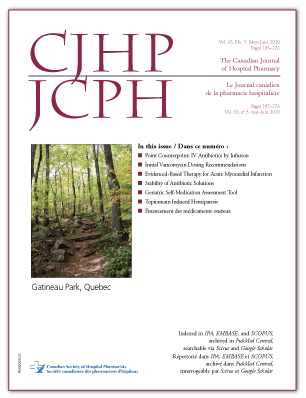Use of Evidence-Based Therapy at Discharge for Patients with Acute Myocardial Infarction: Retrospective Audit of Medical Records
DOI:
https://doi.org/10.4212/cjhp.v63i3.916Keywords:
myocardial infarction, drugs, quality of care, infarctus du myocarde, médicaments, qualité des soinsAbstract
ABSTRACT
Background: Various guidelines are available outlining optimal therapy for patients with acute myocardial infarction. Canadian institutions providing care for such patients have been encouraged to evaluate their care processes using specific indicators.
Objective: To determine the proportion of patients with acute myocardial infarction discharged from a single health authority for whom acetylsalicylic acid (ASA), adrenergic ß-receptor antagonists (ß-blockers), angiotensin-converting enzyme (ACE) inhibitors, or 3-hydroxy-3-methylglutaryl coenzyme A (HMG-CoA) reductase inhibitors (statins) had been prescribed.
Methods: Patients treated over a 12-month period (April 1, 2004, to March 31, 2005) for whom the most responsible diagnosis was acute myocardial infarction were eligible for inclusion in this review. Retrieved data included diagnosis, demographic information, comorbidities, and medications at the time of admission and discharge. Rates of discharge prescribing for the 4 drug classes were calculated for all patients and for “ideal” patients (those without documented contraindications). Rates were compared with published benchmark values.
Results: Medical records for a total of 346 eligible patients were reviewed. Mean age was 65.3 years (standard deviation 13.4 years), and 226 (65.3%) of the patients were male. The coded diagnosis was ST-elevation myocardial infarction for 91 patients (26.3%), non-STelevation myocardial infarction for 164 (47.4%), and myocardial infarction not specified for 91 (26.3%). For “ideal” patients, the prescribing rates were 99.0% (308 of 311 patients) for ASA, 96.3% (310 of 322 patients) for ß-blockers, 90.4% (264 of 292 patients) for ACE inhibitors, and 88.8% (278 of 313 patients) for statins.
Conclusions: Rates of prescribing of ASA, ß-blockers, ACE inhibitors, and statins for “ideal” patients discharged after treatment for acute myocardial infarction exceeded the published Canadian benchmark rates (≥ 90% for ASA, ≥ 85% for ß-blockers and ACE inhibitors, ≥ 70% for statins).
RÉSUMÉ
Contexte : Il existe diverses lignes directrices décrivant le traitement optimal pour les patients ayant subi un infarctus aigu du myocarde. Les établissements de santé canadiens qui soignent de tels patients ont été encouragés à évaluer leurs processus de soins en utilisant des indicateurs précis.
Objectif : Déterminer la proportion de patients ayant subi un infarctus aigu du myocarde et ayant reçu leur congé d’une seule régie de la santé avec une prescription d’acide acétylsalicylique (AAS), d’antagoniste des récepteurs β-adrénergiques (β-bloquant), d’inhibiteur de l’enzyme de conversion de l’angiotensine (ECA) ou d’inhibiteur de la 3-hydroxy- 3-méthylglutaryl-coenzyme A (HMG-CoA) réductase (statine).
Méthodes : Les patients traités sur une période de 12 mois (entre le 1er avril 2004 et le 31 mars 2005) et dont le diagnostic le plus responsable était celui d’infarctus aigu du myocarde étaient admissibles à l’analyse. Les données recueillies incluaient le diagnostic, les renseignements démographiques, les comorbidités et les médicaments au moment de l’admission et du congé. Un taux de prescription au congé pour les quatre classes de médicaments a été calculé pour tous les patients et pour les patients « idéaux » (ceux sans contre-indications documentées). Ces taux ont été comparés aux références optimales publiées.
Résultats : Les dossiers médicaux d’un total de 346 patients admissibles ont été analysés. L’âge moyen des patients était de 65,3 ans (écart-type de 13,4 ans) et 226 (65,3 %) des patients étaient des hommes. Le diagnostic codé était un infarctus du myocarde avec élévation du segment ST (91 patients ou 26,3 %), un infarctus du myocarde sans élévation du segment ST (164 ou 47,4 %) et infarctus du myocarde non précisé (91 ou 26,3 %). Pour les patients « idéaux », les taux de prescription étaient de 99,0 % (308 des 311 patients) pour l’AAS, de 96,3 % (310 des 322 patients) pour les β-bloquants, de 90,4 % (264 des 292 patients) pour les inhibiteurs de l’ECA et de 88,8 % (278 des 313 patients) pour les statines.
Conclusions : Les taux de prescription d’AAS, de β-bloquants, d’inhibiteurs de l’ECA et de statines pour les patients « idéaux » ayant reçu leur congé après le traitement de l’infarctus du myocarde dépassaient les taux de référence canadiens publiés (≥ 90% pour l’AAS, ≥ 85% pour les ß-bloquants et les inhibiteurs de l’ECA, ≥ 70% pour les statines).
Downloads
Downloads
Issue
Section
License
Copyright © Canadian Society of Healthcare-Systems Pharmacy.
After publication of a manuscript in the CJHP, the authors of the manuscript must obtain written permission from the CSHP (publications@cshp.ca) before reproducing any text, figures, tables, or illustrations from the work in future works of their own. If a submitted manuscript is declined for publication in the CJHP, all said rights shall revert to the authors. Please note that any forms (e.g., preprinted orders and patient intake forms) used by a specific hospital or other health care facility and included as illustrative material with a manuscript are exempt from this copyright transfer. The CJHP will require a letter from the hospital or health care facility granting permission to publish the document(s).










